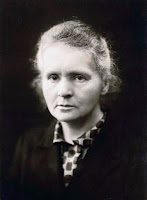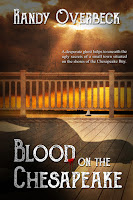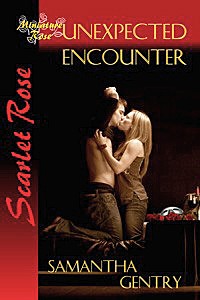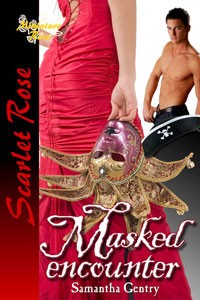Randy Overbeck is my blog guest this week with his new release, CRIMSON AT CAPE MAY, published by The Wild Rose Press. With Halloween only a month away, ghosts are certainly a timely topic.
~~~~~~~~~~~~~~~~~~~~~~~~~~~~~~~~~~~~~~~~~~~~~~~~~~~~~~~~~~~~
“Do you really believe in ghosts?”
During my author talks and book
signings for my new ghost story/mystery, BLOOD ON THE CHEASAPEAKE—at least,
before the pandemic—this is the most common question I’d receive from
participants, sometimes offered with an inflection that conveyed the speakers’
incredulity. It was almost as if the person were saying, “Only children and
idiots believe in ghosts.”
The short answer to that question is
yes, but I prefer Shakespeare’s eloquence, “There is more to heaven and earth,
Horatio, than is dreamt of in your philosophy.” (That’s from Hamlet, by
the way.) For those not fluent in Shakespearian English, he is simply saying
there are just a great many things we simply can’t explain…and ghosts are one
of these.
These skeptics are surprised to
learn that the belief in ghosts is quite widespread among Americans. According
to two studies conducted in the last few years (Harris Poll,2003 and Huntington
Post, 2017) approximately half of Americans report that they believe in ghosts
(48%). And an amazing one in five confirm they’ve experienced an actual
encounter with a spirit from the other side. BTW, the percentage of believers
worldwide is even greater.
In fact, if you are born into a faith community anywhere across the globe, your belief system includes a belief in ghosts and spirits of the dead. For example, Catholics preach that ghosts are “evil spirits that lead you to sin.” Judaism includes the belief in several ghosts including the “dybbuk,” a ghost of a dead person who can possess another for malevolent reasons. Muslims believe in mischievous ghosts called “jinns”—which are better known in the Western world as genies.
Buddhists subscribe to the belief in “hungry ghosts” who exist on another plane, and should be treated with compassion rather than feared. The religions of all Native American tribes include the belief in ghosts such as the evil “Skinwalkers” of Navaho mythology. Of course, this is a partial list, but you get the idea.Skeptics are even more surprised to learn that a number of famous scientists, inventors, statesmen and celebrities openly profess their belief in ghosts.
Marie Curie, the only woman to win two Nobel prizes for her work with radioactive elements—and was the subject of the recent Netflix film, Radioactive—also believed in ghosts and attend seances. Thomas Edison, who holds more patents than any other American, confided to a reporter he was working on a “spirit phone” so he could talk to the dead. Dale Earnhardt, Jr, (known in racing circles as simply Junior) has won more NASCAR races than I could name, but almost died more than fifteen years ago. In 2004, he wrecked in the LeMans Race in Sonoma, CA and was trapped inside a burning car. He says a ghost pulled him from the wreck and saved his life.Also, Presidents
Abraham Lincoln and
Ronald Reagan were very candid about their belief in ghosts. These are merely a few examples.
Overall, I’d say I was in pretty
good company.
So as I imagined, drafted, created and wrote the novels in my new series, the Haunted Shores Mysteries, I was intrigued enough about the possibilities of the spirit world to wrap each cold case murder mystery inside an eerie ghost story. Of course, readers don’t need to believe in ghosts to enjoy these narratives as there is so much more to savor. In each novel, they encounter a perplexing whodunit, a captivating romance, spectacular scenery and a compelling social issue—all this in addition to an eerie ghost. The first entry in the series, BLOOD ON THE CHESAPEAKE, was published last year by the Wild Rose Press and earned rave reviews and even picked up two national awards.
The second installment in the series, CRIMSON AT CAPE MAY, was
released this summer and it quickly garnered two ★★★★★ reviews and a national award, the Gold Award from Literary
Titan. CRIMSON follows our hero, Darrell Henshaw—teacher, coach and paranormal
sensitive—to the incredible resort town at the tip of New Jersey. There, he is
stalked by the Haunted Bride, who is desperate for him to seek justice for her,
and many more victimized girls.
Reviewers have been generous in their praise of the work:
“A haunting, yet fast-paced whodunit that captures the reader’s attention from page one. A wonderful book!”—Alexandra Ivy, New York Times and USA Today bestselling author
http://www.longandshortreviews.com/book-reviews/crimson-at-cape-may-by-randy-overbeck/
“With both elements of mystery and suspense, readers across genres will find this second book about Darrell Henshaw intriguing…I highly recommend it.” ★★★★★—Literary Titan
https://literarytitan.com/2020/02/04/crimson-at-cape-may/
“It’s a ghost/mystery story filled with suspense and action. The plot is so engrossing it had me hooked from the very first page.” ★★★★★—Nana’s Reviews, Greece
“The well-plotted storyline keeps a steady pace through two-thirds of the book and then gradually ups the ante, adds tension, grit, drops more pieces of the puzzle then explodes.”—V. Williams, Rosepoint Publishing
CRIMSON AT CAPE MAY—BLURB
No matter how far you run, you can never really escape a haunted past.
Darrell Henshaw—teacher, coach, and paranormal sensitive—learned
this lesson the hard way. With his job gone and few options, he heads for Cape
May to coach a summer football camp. The resort town, with gorgeous beaches,
rich history and famous Victorian mansions, might just be the getaway he needs.
Only, no one told him Cape May is the most haunted seaport on the East Coast.
One resident ghost, the Haunted Bride, stalks Darrell, begging for his help.
He can’t refuse.
Joining forces with Cassie, a street-wise teen and another
sensitive, he investigates the bride’s death and discovers her murder is
connected to a far greater horror. But can Darrell and Cassie expose those
behind the crimes before they end up being the killer’s next victims?
CRIMSON AT CAPE MAY—EXCERPT
Why
would this woman pursue him?
Now a
safe distance away, he studied her. She was thin, with a small, drawn face of
pasty skin, and he would’ve guessed her to be about his age, mid-twenties. But
there was something about her, something that made him shiver. Did she have a
black eye? Were those cuts on her cheek? Why hadn’t he noticed those before,
when he passed her on the Promenade?
He sped
up, the street crowded, congested with tourists. Normally, the jostling bodies
would’ve given him the creeps, but today he was grateful for the numbers so he
could blend in.
Not sure
where he was headed—except away from his boardinghouse—he kept up a brisk pace.
He hurried past the legendary Inn of Cape May, with its ornate, white period
architecture and four stories of ancient rooms facing the beach. Any other
time, he’d be thinking about taking Erin there. The place had an interesting
old-time vibe. That is, if she still wanted anything to do with him. But he
didn’t have time for that now. He kept moving.
As he
turned back onto Beach Avenue again, the sight of the beautiful blue ocean
across the road struck him and he stopped for a moment, then chanced a peek
back around the corner. No sign of his stalker.
He
reduced his pace, easing past a beach shop, and saw his reflection in the store
front. That gave him an idea. Ahead, he spied a coffee shop with two long
windows facing the street, the panes so sparkling clean he could see the image
of the sun hanging over the ocean in the glass. As he walked along, he turned
his head to catch his image and, when he was far enough along, he glanced
sideways at the window. Trailing behind him, he could make out, reflected in
the glass, only two people, a gray-haired couple. No one else. He took a few
more steps, watching and slowing a little, and exhaled. He’d lost her.
He
turned and studied the man and woman, who’d paused to examine the restaurant
menu posted next to the door. A few feet beyond the couple stood the woman.
Darrell’s gaze darted. The couple. The woman. The coffee shop window. Back to her. The petite young woman in the tattered
white dress stood hunched not more than ten feet away. Darrell searched for her
reflection in the glass. There was not even a shimmer.
Oh no.
Not again.
The side
of the young woman’s face was beaten and bloodied. Her exposed neck bore a
long, ugly purple bruise. The torn dress now had blood seeping across her torso
and down her right leg. He looked back. Still nothing in the window. The hairs
on his neck stood up.
“What do
you want?”
In
unison, the pair turned, peered behind and then back at Darrell. The man said,
“Son, there’s no one there.”
Darrell
kept staring and as he watched, the young woman walked through the older couple and stopped in front of him. This close
up, her one deep blue eye—the one not blackened—seemed vacant and carried an emptiness
that frightened Darrell. She again extended both pale hands, blood now covering
them and dripping off her fingertips. Mesmerized, Darrell watched as fat
crimson drops splattered red onto the gray sidewalk.
In her
soft voice, she said again, “Please, help me. Help us.”
Darrell
shook his head violently. “No. Hell, no. Not again.” Last time almost killed
him.
Why
would this woman pursue him?
Now a
safe distance away, he studied her. She was thin, with a small, drawn face of
pasty skin, and he would’ve guessed her to be about his age, mid-twenties. But
there was something about her, something that made him shiver. Did she have a
black eye? Were those cuts on her cheek? Why hadn’t he noticed those before, when
he passed her on the Promenade?
He sped
up, the street crowded, congested with tourists. Normally, the jostling bodies
would’ve given him the creeps, but today he was grateful for the numbers so he
could blend in.
Not sure
where he was headed—except away from his boardinghouse—he kept up a
brisk pace. He hurried past the legendary Inn of Cape May, with its ornate, white
period architecture and four stories of ancient rooms facing the beach. Any
other time, he’d be thinking about taking Erin there. The place had an interesting
old-time vibe. That is, if she still wanted anything to do with him. But he
didn’t have time for that now. He kept moving.
As he
turned back onto Beach Avenue again, the sight of the beautiful blue ocean
across the road struck him and he stopped for a moment, then chanced a peek back
around the corner. No sign of his stalker.
He
reduced his pace, easing past a beach shop, and saw his reflection in the store
front. That gave him an idea. Ahead, he spied a coffee shop with two long windows
facing the street, the panes so sparkling clean he could see the image of the
sun hanging over the ocean in the glass. As he walked along, he turned his head
to catch his image and, when he was far enough along, he glanced sideways at
the window. Trailing behind him, he could make out, reflected in the glass, only
two people, a gray-haired couple. No one else. He took a few more steps,
watching and slowing a little, and exhaled.
He’d
lost her.
He
turned and studied the man and woman, who’d paused to examine the restaurant
menu posted next to the door. A few feet beyond the couple stood the woman.
Darrell’s gaze darted. The couple. The woman. The coffee shop window. Back to
her. The petite young woman in the tattered white dress stood hunched not more
than ten feet away. Darrell searched for her reflection in the glass. There was
not even a shimmer.
Oh no.
Not again.
The side
of the young woman’s face was beaten and bloodied. Her exposed neck bore a
long, ugly purple bruise. The torn dress now had blood seeping across her torso
and down her right leg. He looked back. Still nothing in the window. The hairs
on his neck stood up.
“Why
are you following me? What do you want?”
Darrell
kept staring and as he watched, the young woman walked through the older couple
and stopped in front of him. This close up, her one deep blue eye—the one not
blackened—seemed vacant and carried an emptiness that frightened Darrell. She
again extended both pale hands, blood now covering them and dripping off her
fingertips. Mesmerized, Darrell watched as fat crimson drops splattered red
onto the gray sidewalk.
In her
soft voice, she said again, “Please, help me. Help us.”
AUTHOR BIO
Dr. Randy Overbeck is an
award-winning educator, writer and speaker who has earned recognition in the
Midwest and beyond. As
a member of the Mystery Writers of America, Dr. Overbeck is an active member of
the literary community, contributing to a writers’ critique group, serving as a
mentor to emerging writers and participating in writing conferences such as
Sleuthfest, Killer Nashville and the Midwest Writers Workshop. When he’s not
writing or researching his next exciting novel or sharing his presentation
“Things That Go Bump in the Night,” he’s spending time with his incredible
family of wife Cathy, three children (and their spouses) and seven wonderful
grandchildren.
Published by The Wild
Rose Press in trade paper (ISBN: 978-1-5092-3163-8, 403 pages $18.98) and eBook
($4.99) editions, Crimson at Cape May is available wherever fine books
are sold. The Wild Rose Press (www.thewildrosepress.com) is an independent
fiction publisher based in New York.
Randy
Overbeck
randyoverbeck@authorrandyoverbeck.com
@OverbeckRandy
FB: Author
Randy Overbeck
Purchase Links
https://www.barnesandnoble.com/w/crimson-at-cape-may-randy-overbeck/1137088608?ean=9781509231638
https://www.bookbub.com/books/crimson-at-cape-may-by-randy-overbeck


















































